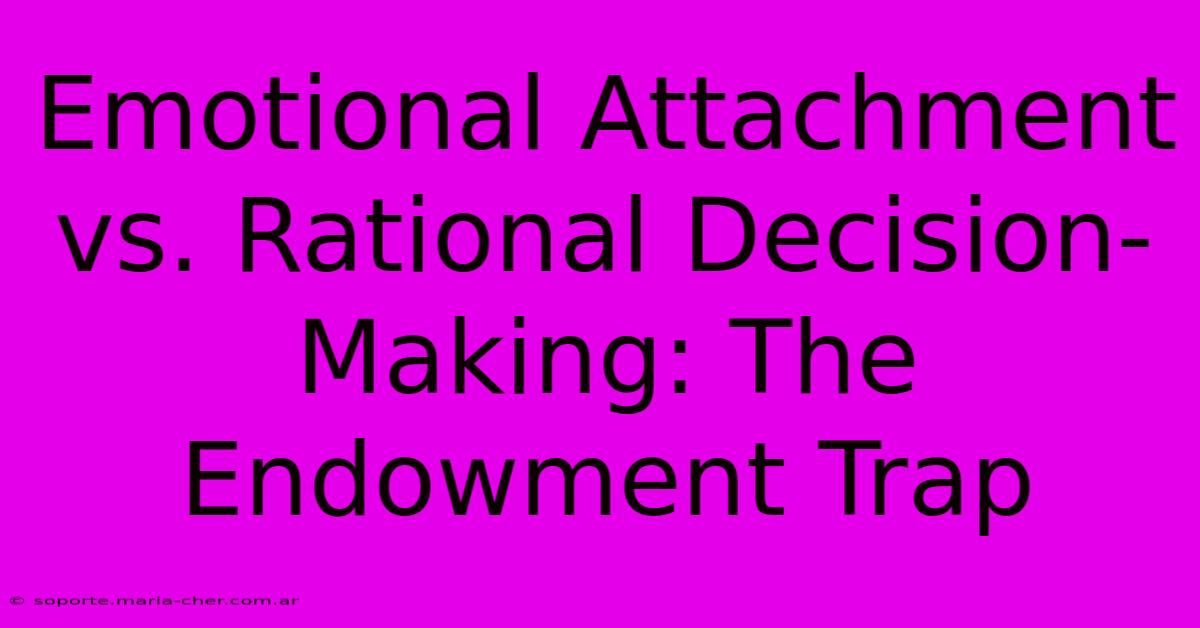Emotional Attachment Vs. Rational Decision-Making: The Endowment Trap

Table of Contents
Emotional Attachment vs. Rational Decision-Making: The Endowment Trap
We all know the feeling: you've owned something for a while, and suddenly, its value skyrockets in your eyes. This isn't necessarily due to an actual increase in market price; it's the endowment effect, a cognitive bias where we place a higher value on things we already possess than on identical things we don't own. This seemingly simple phenomenon highlights the powerful interplay between emotional attachment and rational decision-making, often leading us into what behavioral economists call the endowment trap.
Understanding the Endowment Effect
The endowment effect stems from our innate tendency to avoid losses more than we seek gains (loss aversion). Once we "own" something – be it a material object, a piece of property, or even an idea – we feel a sense of ownership and experience a psychological loss if we were to part with it. This feeling can significantly skew our perception of its worth, making us unwilling to sell it even at a price considerably higher than we'd be willing to pay to acquire it.
Examples of the Endowment Trap in Action:
- The "Mug" Experiment: A classic study involved giving participants a mug. When asked how much they'd sell it for, they demanded a significantly higher price than those who were asked how much they'd pay to buy an identical mug.
- Selling Your Car: Have you ever noticed how much more attached you become to your car, even when it's old and needs repairs? Selling it feels like losing a part of yourself, influencing the price you're willing to accept.
- Investing in Stocks: Holding onto underperforming stocks due to emotional attachment, rather than selling and cutting your losses, is a common manifestation of the endowment trap.
The Conflict Between Emotion and Logic
The endowment trap represents a direct conflict between our emotional responses and logical, rational decision-making. While logic might dictate selling an asset for a profit or cutting losses, our emotional attachment prevents us from making the objectively better choice. This conflict can lead to:
- Missed Opportunities: Holding onto assets that are depreciating in value prevents us from reinvesting in potentially more profitable ventures.
- Financial Losses: The unwillingness to sell underperforming assets can lead to significant financial losses.
- Regret and Cognitive Dissonance: After finally selling something, many experience regret, even if it was the rational choice, due to the emotional attachment that lingers.
How to Avoid the Endowment Trap
Recognizing the endowment effect is the first step towards overcoming it. Here's how to make more rational decisions:
1. Detach Emotionally:
Try to view your possessions objectively. Ask yourself: "If I didn't already own this, would I buy it at the current market price?"
2. Focus on Opportunity Cost:
Consider the potential gains you could achieve by investing the money you could receive from selling an asset. What else could you buy or invest in?
3. Seek External Advice:
Consult with a financial advisor or other impartial expert to get an objective perspective on the value of your assets.
4. Practice Mindfulness:
Be aware of your emotional responses when considering selling something. Recognize when your attachment is clouding your judgment.
5. Reframe Your Thinking:
Instead of focusing on the potential loss of selling an item, focus on the potential gains from reinvesting the proceeds.
Conclusion: Rationality Over Attachment
The endowment trap is a powerful reminder that our emotions can significantly impact our financial and even life decisions. By understanding the psychological mechanisms behind this bias, and employing strategies to mitigate its influence, you can make more rational, informed decisions that align with your long-term goals. Remember, objectivity and a focus on opportunity cost are key to escaping the endowment trap and making the most of your resources.

Thank you for visiting our website wich cover about Emotional Attachment Vs. Rational Decision-Making: The Endowment Trap. We hope the information provided has been useful to you. Feel free to contact us if you have any questions or need further assistance. See you next time and dont miss to bookmark.
Featured Posts
-
Youthful Brilliance How Millennial Ph Ds Are Revolutionizing Academia
Feb 07, 2025
-
Stitch It Up Or Plant It Sewed Or Sowed The Ultimate Guide
Feb 07, 2025
-
Piercing Perfection Unleash Your Earring Potential With A Second Hole
Feb 07, 2025
-
Grad School Secrets Revealed The Inside Track To A Killer Ph D Journey
Feb 07, 2025
-
Unveiling The Secrets Print Perfect Labels On Rolls 90640 In 5 Simple Steps
Feb 07, 2025
